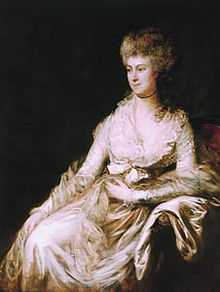Francesca Lebrun

Francesca Lebrun, née Danzi (24 March 1756 – 14 May 1791), was a noted 18th-century German singer and composer.
She was born Franziska Dorothea Danzi in Mannheim, Germany. Her father was the Italian-born cellist Innocenz Danzi and her younger brother was the composer and cellist Franz Danzi (1763–1826). She was renowned for her vocal dexterity and highly sought after by notable contemporaries, such as Anton Schweitzer, Ignaz Holzbauer, and Antonio Salieri, for the lead roles in their most challenging opuses.
Her talent extended beyond the stage to the manuscript tablet and the keyboard; twelve sonatas for fortepiano and violin of hers survive, six of which have been recorded.
Biography
Francesca was the eldest child in the family of gifted musicians. Her mother (Barbara Toeschi), a dancer, and her father (Innocenz Danzi), an Italian cellist, were the core of the elite elector Mannheim court performers in the late 1750s. Her brothers, Franz (Ignaz) Johann Baptist were cellist and violinist respectively and were successful composers.
She made her first public appearance as a singer at the age of 16 and the following year was engaged by the Mannheim Opera. There seems to be some debate whether she first performed in Gassmann’s L’amore artigiano in May 1772, or Sacchini’s La Contadina in Corte, the role for which she earned the title virtuosa da camera. She stayed with the Mannheim court opera for four years and was cast in the premier roles: Parthenia in Anton Schweitzer's Alceste (1775, Schlosstheater Schwetzingen), and Anna in Holzbauer’s Günther von Schwarzburg (1777), a role composed specifically for her voice. At twenty-one she traveled to London to sing four opera series by J.C. Bach & Sacchini.
In 1778, she married oboe virtuoso and composer Ludwig August Lebrun (1746–1790) from Mannheim. That summer, now known as Signora Lebrun, she toured Italy with Ludwig. At the opening of the Teatro alla Scala in Milan on August 3, 1778, Francesca Lebrun was the female lead in Antonio Salieri's opera Europa Riconosciuta. She created a sensation in 1779 in Paris at the Concert Spirituel through her ability to fit Italian words to instrumental parts of symphonies concertantes and sing them. The Lebruns lived in London from 1779 through 1781 while Francesca appeared at the King's Theater. In 1780 the celebrated English artist Thomas Gainsborough painted her portrait.
Her compositions for Fortepiano and Violin were published in 1780. Schubart noted that she could sing A, 3 octaves above middle C with ‘clarity and distinctness’. Charles Burney wrote that and when she and her husband performed divisions of thirds and sixths it was impossible to discover who was uppermost of the interval. A celebrated soprano, she sang on major operatic and concert stages through Europe, including England, Germany and Italy to great acclaim.
Francesca’s family flourished as well, she gave birth to daughter Sophie while in London in June 1781 and daughter Rosine in 1783 in Munich. Francesca and Ludwig toured around Europe again in 1785, spending a season in Naples, then Berlin and London where Ludwig eventually passed in 1790. She performed only twice after his death and survived him by only five months, dying on 14 May 1791 at the age of 35. Incidentally, she was born and died in the same years as Mozart.
She was a respected composer of sonatas for violin and piano. It is thought, too, that she was a fine pianist, as reflected in her writing for the instrument.
Her daughters also became well-known. Rosine Lebrun (1783–1855) was a successful opera singer and actress and was a member of the Munich theatre company, 1801–30. Sophie [Dülken] (1781-1863) became a well-known pianist and composer. Sophie’s daughters and their daughters also became musicians.
Discography
- Francesca LeBrun (1756–1791), Six Sonatas for Fortepiano and Violin, Op. 1, World Premiere Recording of Complete OP.1
- Women Composers At The Courts Of Europe Sonata (6) for Piano and Violin, Op. 1: no 2 in E flat major by Francesca Lebrun
Sources
|